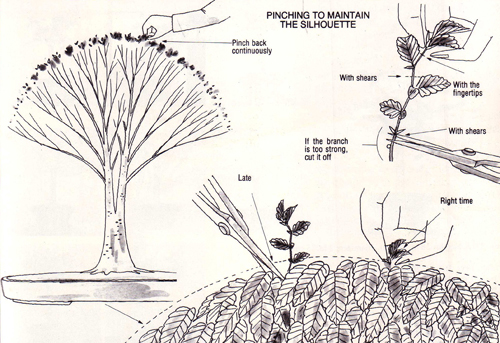This Zelkova serrata (sometimes called Greybark elm and sometimes called just Zelkova) is a classic broom style bonsai. Often when you think of broom style, you think of Zelkova (and vise versa). However, neither broom style nor zelkova are what inspired this post (see below). Photo from Bonsai Today issue 26.
You asked for it
A while back someone asked for some info on designing apices (plural for apex). At the time I promised that we would post something very soon and then proceeded to neglect to do it. So, here’s the beginning of a series on bonsai apices. Better late…

As you can see, this illustration (also from BT26) shows how to maintain the silhouette on a zelkova broom style bonsai. Pretty simple, and the good news is that this technique (or variations on it) can apply to many types of trees in various styles, though you don’t want to be too literal as there are differences that crop up (so to speak).
Apex, Canopy, Crown: Whatcha Got?
I’ve heard and seen a mix of uses of these three terms and would be interested to see how you use them. Do you distinguish between all three? Two? Not at all?
Big discounts on Bonsai Today back issues
Over at Stone Lantern we are running a sale with some very large discounts on Bonsai Today back issues, as well as books and kenzans.
Definietly apex for the top of a bonsai, for the following Etymological reasons.
Apex: Latin “summit, peak or tip”.
Crown: Originally from the Greek korone “anything curved, kind of crown”… the only usage meaning “the top” of something is in reference to the human skull, first used in 13th Century English.
Canopy: the whole of the foliage, definitely not just the top, from the originally derived from the Old French conope “bed-curtain” and in turn from the Greek konopeion “couch with mosquito net” and konops “mosquito, gnat”.
Thanks for your very well written and thorough explanation. I couldn’t agree more.